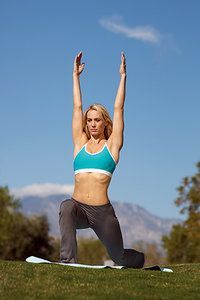Some doctors thrive in a personality-based clinic and have a loyal following no matter what services or equipment they offer, but for most chiropractic offices who are trying to grow and expand, new equipment purchases help us stay relevant and continue to service our client base in the best, most up-to-date manner possible. So, regarding equipment purchasing: should you lease, get a bank loan, or pay cash?
The Tall- to Half-Kneeling Assessment
The brilliant dancer Martha Graham once said, "Movement never lies." And oh, how right she was in making that profound statement. During initial evaluations and examinations, it is standard procedure to do diagnostic testing (X-rays, etc.), range of motion, palpation and orthopedic testing. Adding simple movement assessments will give you much information about the patient's individual compensations and adaptations. After all, every patient has to move when they leave your office. Every movement can be a movement assessment, from the moment a patient walks into your office, to how they sit during a consultation, to how they get on and off the treatment table.
One of my favorite movement assessments is the tall- to half-kneeling pattern. This assessment will divulge a great deal of information about the patient's ability to dynamically control movement in all three planes of motion (sagittal, frontal, transverse).
How to Do the Movement
- Instruct the patient to get down on the ground on both knees, maintaining a comfortable and natural distance of separation between one knee and the other.
- Ankles should be dorsiflexed (preferable to have shoes and socks removed during the movement).
- Arms by the sides in phase 1, out to the sides parallel to the ground in phase 2, arms overhead in phase 3. (Each phase is more challenging to the core.) If the patient performs well in phase 1, move to phases 2 and 3. Ideally, the patient should be able to do all three phases.
- Without holding their breath, the patient lifts one leg off the ground straight forward and places the foot on the ground to half-kneeling position; then returns back to starting position in the tall-kneeling position. Slow and controlled motion is key.
- Repeat on the opposite side.
- Repeat pattern for four repetitions, alternating sides.
Editor's note: Review Dr. Nickelston's demonstration video illustrating the movement, including the three progression phases he references above.
<iframe width="560" height="315" src="https://www.youtube.com/embed/puokxouKgAs?rel=0" frameborder="0" allowfullscreen></iframe>
What to Look for; What It Means
Observe how the patient gets down to the ground and back up. Most people are not comfortable going down to the ground into a tall-kneeling position. The assessment is designed to put them outside of their comfort zone and see what path their nervous system takes to get them to the goal of tall-kneeling. Why should they do this movement? Because it's a fundamental necessity of motion to be able to control your body up and down off the ground.
What happens if someone falls? Can they get back up? Inability to get down to the position indicates a patient may have a fear of the movement, a stability dysfunction or a joint mobility restriction.

When in tall-kneeling, can they maintain a straight-line position from the knees, hips, and shoulders? Flexion in the midline may indicate a tight iliopsoas and rectus femoris pulling the pelvis into anterior pelvic tilt; poor hip extension (hip mobility restriction); thoracic hyperkyphosis; poor ankle dorsiflexion range of motion and/or poor big toe extension (adequate should be 65 degrees); and/or possible inhibition of the transverse abdominis, rectus abdominis, internal and external oblique, and gluteus maximus, which are posterior pelvic tilt muscles.
When transitioning into half-kneeling, you are assessing the stability of the downward hip, strength of the moving leg, and lateral subsystem of stabilization. Watch for controlled movement. Speeding through a movement indicates lack of stabilization. Patients commonly use speed and momentum to cover up dysfunction.
The Dysfunctional Lateral Subsystem
In the video, notice that when my right knee is down and I bring the left leg forward, there is a rounding and hip hiking of the left side. I also have a slight lateral flexion to the left side, indicating facilitated QL and/or obliques. The transition into half-kneeling stresses the stabilization of the lateral subsystem of movement (in this case, the right hip adductors and gluteus medius, and the left quadratus lumborum.) Hip hiking may indicate facilitation and overactivity of the left quadratus lumborum, inhibition of the left iliopsoas, and lack of hip mobility.
The downward leg may be lacking hip stability from inhibition of the gluteus medius, and/or adductors, causing a compensation in left hip swing. Weakness in the lateral subsystem leads to dysfunctional patterning in the frontal plane.
If the LSS is dysfunctional, impact forces will be transmitted into peripheral joints which may be recruited for stability. Joints and soft tissue become more vulnerable to injury and overuse syndromes, (sprains, strains, tendinitis, bursitis, etc.). The extremities are power amplifiers of the core. When the core loses its ability to initiate power, the extremities must work that much harder to generate and control force. The extra work decreases durability and increases risk of injury.
What are some of the signs of a dysfunctional lateral subsystem? Common symptoms and syndromes include the following:
- Recurring knee pain
- Hip pain
- ITB syndrome pain
- Pulled groin
- Adductor injury
- Sacroiliac pain
- Plantar fasciitis
- Sciatica pain
- Ankle injuries
- Lower back pain
What If You Find Dysfunction?
A dysfunctional pattern tells you hip / pelvic mobility and stability work is needed in the care program. Psoas and quadratus lumborum balancing is critical to the ability to maintain stability in the lumbar spine / hip / pelvis. Once the patient gains increased mobility from chiropractic manipulation, a corrective exercise program is needed to teach their brain and nervous system how to control the new range of motion.
The tall-kneeling to half-kneeling movement is an important transition into pulling oneself up in order to stand and eventually walk. Assessing the lateral subsystem is also possible with a single-leg stance test; however, it is often much easier for the patient to compensate and cover up dysfunction. Getting them closer to the ground and reducing their ability to compensate reveals more information.
Introduce the tall- to half-kneeling assessment and you will see the body and brain speak to you via movement. More importantly, the patient will feel and experience the differences from one side to the other. That creates value beyond simply having less pain; they will achieve improved function that positively impacts just about everything they do.
Resources
- Cook G. Movement Functional Movement Systems: Screening, Assessment, Corrective Strategies. Cork: BookBaby, 2010.
- Elphinston J. Stability, Sport and Performance Movement: Practical Biomechanics and Systematic Training for Movement Efficacy and Injury Prevention 2nd Edition. Aptos, CA: Lotus Pub, 2013.
- Vleeming A. Movement, Stability & Lumbopelvic Pain: Integration of Research and Therapy 2nd Edition. Edinburgh: Churchill Livingstone Elsevier, 2007.
- Weinstock D. NeuroKinetic Therapy: An Innovative Approach to Manual Muscle Testing Berkeley, CA: North Atlantic, 2010.



